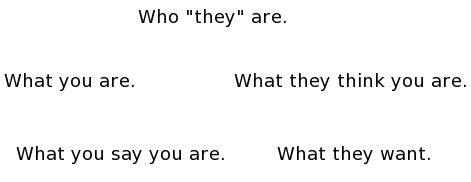Alignment in Marketing
A couple of months ago I asked a marketing consultant to work with me as a marketing coach. As we have discussed and debated the basics of marketing strategy at my companies, floating words like these have often sprung up in my mind’s eye.

Where is the starting point, and in what order would we arrange them? Should we determine who buys from us now, and target them as our “they”, or should we decide for strategic reasons to target someone else? Are we doing market research so we can find out what they want us to be, and then say we are that? (What if we aren’t?) Should we tell the simple truth about what we are, and let whoever wants that be our “they”? Should we change what we are, so we can change what we say? These questions shape the core of a marketing (and company) strategy.
Here are my conclusions so far:
1. Probably the most important decision that marketers have to make, and the one with the widest range of valid answers, is the “who” question. Who they are, the potential customers. Look at the various potential targets out there, and understand what they want. Compare what they want to what you are good at, or could be good at. The targets who most want what you can best provide are probably the right “they” for you.
2. What they want comes next. You don’t get to choose what they want, you just get to find out. (If what they want is not something you are willing to give to them, you have the wrong they.)
3. What we are comes next. If it’s not already a perfect match, what we are must now be conformed to what they want as much as is ethically and practically possible. I see a lot of companies skipping or skimping on this one.
4. What we say we are comes next, and must match what we really are. They don’t have the attention span to listen to the whole truth though, so what we say we are will be a subset of the truth. Since we already matched what we are to what they want, we will now be truthfully saying that we are what they want, which is convenient.
5. What they think we are comes next. Early on this is influenced by what we say we are, and what others say we are. Long term it will trend toward what we really are, because actions (and experiences) speak louder than words. Since we already lined everything up, they won’t be surprised or need to change their mind later.
If what you say you are doesn’t match what you are, you aren’t telling the truth, and they will find out, sooner rather than later.
If what you are doesn’t match what they want, they will ignore you and find someone else (in 10 seconds on Google).
If what you are doesn’t match what anyone wants, you have a personal cause, or a personal hobby, but not a business.
If what they think you are doesn’t match what you are, they are getting the wrong signals, either from you or from others.
If they think you are what you say you are, and you say you are what you are, and you are what they want, your marketing is aligned with who they are.
